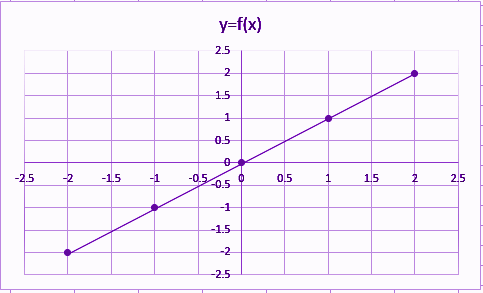The identity function is a function which returns the same value, which was used as its argument. It is also called an identity relation or identity map or identity transformation. If f is a function, then identity relation for argument x is represented as f(x) = x, for all values of x. In terms of relations and functions, this function f: P → P defined by b = f (a) = a for each a ϵ P, where P is the set of real numbers. Both the domain and range of function here is P and the graph plotted will show a straight line passing through the origin.
Identity Function Definition
Let R be the set of real numbers. Thus, the real-valued function f : R → R by y = f(a) = a for all a ∈ R, is called the identity function. Here the domain and range (codomain) of function f are R. Hence, each element of set R has an image on itself. The graph is a straight line and it passes through the origin. The application of this function can be seen in the identity matrix.
Mathematically it can be expressed as;
| f(a) = a ∀ a ∈ R |
Where a is the element of set R.
For example, f(2) = 2 is an identity function.
In set theory, when a function is described as a particular kind of binary relation, the identity function is given by the identity relation or diagonal of A, where A is a set.
Also, read:
Identity Function Graph
If we plot a graph for identity function, then it will appear to be a straight line. Let us plot a graph for function say f(x) = x, by putting different values of x.
| x | -2 | -1 | 0 | 1 | 2 |
| f(x) = y | -2 | -1 | 0 | 1 | 2 |
Now as you can see from the above table, the values are the same for both x-axis and y-axis. Hence, let us plot a graph based on these values.

So, from the above graph, it is clear that the identity function gives a straight line in the xy-plane.
Let us solve some examples based on this concept.
Identity Function Example
Q.1: Prove f(2x) = 2x is an identity function.
Solution: Given, f(2x) = 2x
Let us put the values of x in the given function.
If x = 1, then;
f(2(1)) = 2(1) ⇒ f(2) = 2
If x = 2, then;
f(2(2)) = 2(2) ⇒ f(4) = 4
If x = 3, then;
f(2(3)) = 2(3) ⇒ f(6) = 6
If x = 0, then;
f(2(0)) = 2(0) ⇒ f(0) = 0
Let us try with some negative values of x.
If x =-1, then;
f(2(-1)) = 2(-1) ⇒ f(-2) = -2
If x = -2, then;
f(2(-2)) = 2(-2) ⇒ f(-4) = -4
If x = -3, then;
f(2(-3)) = 2(-3) ⇒ f(-6) = -6
Let us draw a table for all values of x.
| x | -3 | -2 | -1 | 0 | 1 | 2 | 3 |
| y=f(x) | -6 | -4 | -2 | 0 | 2 | 4 | 6 |
Let us draw the graph for these values.

You can see from the above graph. The function f(2x) = 2x plots a straight line, hence it is an identity function.
Properties of Identity Function
- It is a linear operator in case of application of vector spaces.
- For positive integers, it is a multiplicative function.
- For m-dimensional vector space, it is expressed as identity matrix Im.
- In topological space, this function is always continuous.
I am new one to byjus
So please give me instructions for it